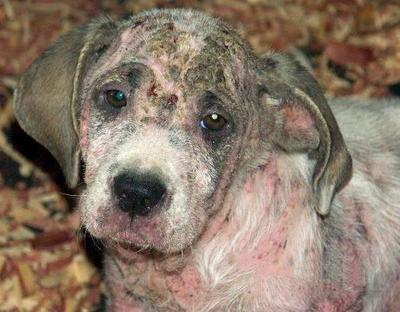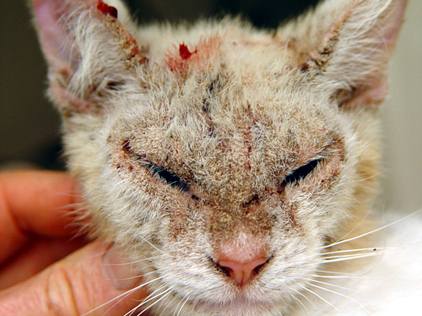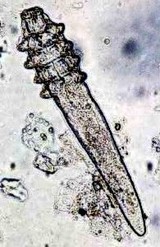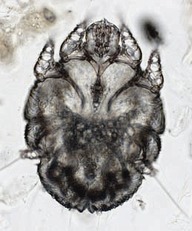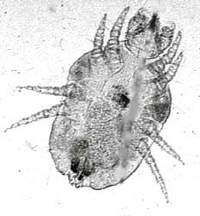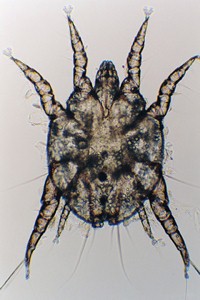Dog and cat with advanced demodectic and sarcoptic mange, respectively
What is Mange?
Mange is a category of persistent skin diseases caused by parasitic mites living and breeding on or under the skin causing immense discomfort for the animal.
The most common types of mange in dogs and cats are demodectic, sarcoptic (or notoedric in cats), and cheyletiella (see pictures below). Another type of mange that we should mention is otodectic mange (commonly known as ear mites) that mainly affects the ears but can also affect other parts of the animal's body. All types of mange are very uncomfortable for your pet and should be treated as soon as possible to avoid serious harm.
Demodectic, Sarcoptic and Otodectic mange mites are microscopic and can only be seen with the aid of a microscope whereas Cheyletiella mites are larger and can be seen with the naked eye or magnifying glass.
Not all types of mange are contagious or create intense itchy skin but all can result in severe skin conditions. Demodectic mange is not contagious to humans or other animals. The condition only afflicts animals with an immature or compromised immune system. However, sarcoptic (or notoedric in cats) and cheyletiella mange transfer easily to humans and other animals through direct contact or infected surroundings. Otodectic mange (or ear mites) is also highly contagious to cats, dogs and other mammals but not to humans.
The most common types of mange in dogs and cats are demodectic, sarcoptic (or notoedric in cats), and cheyletiella (see pictures below). Another type of mange that we should mention is otodectic mange (commonly known as ear mites) that mainly affects the ears but can also affect other parts of the animal's body. All types of mange are very uncomfortable for your pet and should be treated as soon as possible to avoid serious harm.
Demodectic, Sarcoptic and Otodectic mange mites are microscopic and can only be seen with the aid of a microscope whereas Cheyletiella mites are larger and can be seen with the naked eye or magnifying glass.
Not all types of mange are contagious or create intense itchy skin but all can result in severe skin conditions. Demodectic mange is not contagious to humans or other animals. The condition only afflicts animals with an immature or compromised immune system. However, sarcoptic (or notoedric in cats) and cheyletiella mange transfer easily to humans and other animals through direct contact or infected surroundings. Otodectic mange (or ear mites) is also highly contagious to cats, dogs and other mammals but not to humans.
Symptoms
See section below for more specific symptoms and details. Depending on the type of mange - demodectic, sarcoptic (or notoedric) or cheyletiella - and the degree of infestation, the symptoms may vary. However, the typical symptoms for all of these types of mange include hair loss and scaly or crusty skin. In the case of otodectic mange or ear mites, typical symptoms include frequent head shaking and scratching at the ear(s) in addition to the presence of a dark discharge inside the afflicted ear.
Diagnosis
The demodectic and sarcoptic/notoedric mange diagnosis can be made by observing the mites or their eggs under the microscope after obtaining a sample from a deep skin scraping with a scalpel blade.
In some cases, when vets are not able to find the mites despite multiple scrapings but still suspect mange, a piece of skin (biopsy) may be taken and sent to a lab for histopathology. Sometimes mange may be difficult to diagnose with samples obtained from a deep skin scraping. If your pet has sarcoptic (or notoedric) mange, for example, he might have scratched or licked off all the mites on the area from which the sample was taken. Another complication is that demodectic mites are normally present in most dogs, so their appearance under the microscope doesn't necessarily mean they are responsible for your pet's skin condition.
For these and other reasons, your vet may sometimes make a diagnosis based on observation of symptoms rather than actual confirmation of the presence of mites.
The cheyletiella mites are a lot easier to diagnose since they dwell on the skin surface, are larger and can be visible to the naked eye or from a skin sample under the microscope. The animal's owner can easily diagnose this type of mange by brushing the affected area with a dog brush and then tapping the brush on a dark piece of paper. If the flakes that dislodge from the brush move around, these are mites. Additionally, the typical dusting or dandruff present due to a cheyletiella infestation is a good indicator of the presence of these mites.
In the case of otodectic mites or ear mites, your vet can diagnose a mite ear infestation using an otoscope or examining a sample of ear discharge using a microscope.
More information about the various types of mange can be found below to assist you in determining if mange could be your pet's problem and which type of mange mite may be involved.
In some cases, when vets are not able to find the mites despite multiple scrapings but still suspect mange, a piece of skin (biopsy) may be taken and sent to a lab for histopathology. Sometimes mange may be difficult to diagnose with samples obtained from a deep skin scraping. If your pet has sarcoptic (or notoedric) mange, for example, he might have scratched or licked off all the mites on the area from which the sample was taken. Another complication is that demodectic mites are normally present in most dogs, so their appearance under the microscope doesn't necessarily mean they are responsible for your pet's skin condition.
For these and other reasons, your vet may sometimes make a diagnosis based on observation of symptoms rather than actual confirmation of the presence of mites.
The cheyletiella mites are a lot easier to diagnose since they dwell on the skin surface, are larger and can be visible to the naked eye or from a skin sample under the microscope. The animal's owner can easily diagnose this type of mange by brushing the affected area with a dog brush and then tapping the brush on a dark piece of paper. If the flakes that dislodge from the brush move around, these are mites. Additionally, the typical dusting or dandruff present due to a cheyletiella infestation is a good indicator of the presence of these mites.
In the case of otodectic mites or ear mites, your vet can diagnose a mite ear infestation using an otoscope or examining a sample of ear discharge using a microscope.
More information about the various types of mange can be found below to assist you in determining if mange could be your pet's problem and which type of mange mite may be involved.
Mange Type
|
Symptoms
|
Demodectic Mange Mite
|
Demodectic mange is the most common type of mange. The victims of this kind of mange range from very young animals with under-developed immune systems, animals that are stressed, malnourished or ill, or old animals with suppressed immune systems.
Typical symptoms include thinning of the hair frequently around the eyes, mouth and front of the legs (but can occur anywhere on the body) that progress into patches of approximately one inch or more in diameter. These spots can be localized or generalized. If severe, skin lesions may become sore, crusted and oozing. Skin pathology includes hair loss, redness and hyperpigmentation. The lesions may or may not itch depending on whether a secondary infection is present which will cause itching. |
Sarcoptic Mange Mite |
Sarcoptic mange (notroedic mange in cats) usually begins as a series of red bumps that are extremely itchy which will cause the animal to franticly scratch; digging and biting fur or skin in a ferocious manner (similar to flea infestation).
The bumps progress into crusty, raw areas with open oozing sores and loss of hair as a result of self-trauma and secondary infection. Yellow-grey, scale/crusts lesions are characteristically present at the edge of the ears, elbows, legs and face and can become widespread. |
Otodectic Mange Mite |
Otodectic mange typical symptoms include shaking of the head and scratching of the ears, and a dark discharge from the afflicted ears similar to coffee grounds in appearance.
Unpleasant smell may accompany the dark excretions from the ears when continuous scratching leads to secondary infections. Areas of hair loss resulting from self-trauma due to scratching or excessive grooming. A crusted rash around or in the ear. An aural hematoma (large blood blister on the ear) caused by rupture of small blood vessels between the skin and cartilage caused by scratching at the ears. |
The sections below provide more detailed information about the various types of mange.
Demodectic Mange
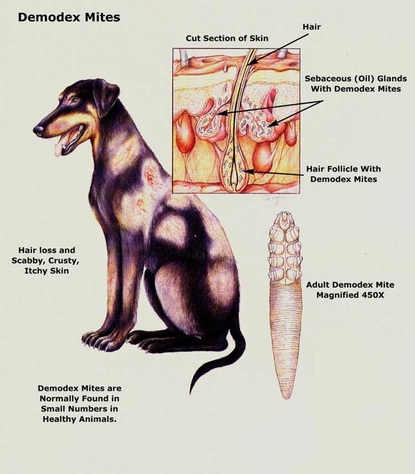
Demodectic mange, also known as red mange or demodicosis, is a skin condition caused by different microscopic species of Demodex mites that are cigar-shaped and eight-legged.
These mites feed and reside in the hair follicle and oil glands of the skin.
In the canine Demodex species, the length of adult mites ranges from 180 to 210 µm for D. canis, 330 to 370 µm for D. injai, and 90 to 140 µm for Demodex sp. “cornei”. In the feline Demodex species, the length of adult mites ranges from 181 to 219 µm for D. cati, 81 to 115 µm for Demodex gatoi, and 170-174 µm for Demodex sp.
It is important to note that Demodex mites are present in small numbers in the skin of all normal animals, including humans, and usually exist within the hair follicles. Therefore, demodectic mange is not considered contagious.
Animals that develop demodectic mange have either an immature immune system (puppies) or an immune system malfunction due to a poor diet, stress, illness or advanced age. When the immune system of the animal is not capable of maintaining the numbers of mites in check, a mite population explosion occurs and the mange condition develops. Secondary bacterial or fungal infections may also develop if there is excessive scratching.
Puppies acquire Demodex mites from close contact with their mother while nursing in the first 2 to 3 days of life. Most cases of juvenile demodectic mange occur between three and six months of age and often the pups outgrow the condition as their immune system matures.
Demodectic mange typically comes in one of two forms: localized or generalized.
The localized form is typically a mild condition involving only one to a few skin sites (less than 5) isolated lesions and is not normally considered very serious. Lesions frequently begin around the eyes, mouth, and over the body extremities, especially the forelegs, but can occur anywhere on the body. The affected areas may vary in size for weeks to months before finally resolving.
The generalized form can progress from a preexisting localized condition to where there will be areas of hair loss over the entire coat (including the head, neck, abdomen, legs, and feet), or it can come up without warning. The symptoms associated with the generalized form are severe hair loss, lethargy, and in some cases fever when certain secondary infections arise.
Once Demodectic mange is suspected, it can usually be confirmed by a deep skin scraping or biopsy, in which case the mites and/or eggs can be seen with the aid of a microscope.
Unfortunately, since these mites are present in most animals, their presence does not necessarily constitute a positive diagnosis of demodectic mange. The presence of the mite must be coupled with the typical lesions for a diagnosis of mange to be made.
These mites feed and reside in the hair follicle and oil glands of the skin.
In the canine Demodex species, the length of adult mites ranges from 180 to 210 µm for D. canis, 330 to 370 µm for D. injai, and 90 to 140 µm for Demodex sp. “cornei”. In the feline Demodex species, the length of adult mites ranges from 181 to 219 µm for D. cati, 81 to 115 µm for Demodex gatoi, and 170-174 µm for Demodex sp.
It is important to note that Demodex mites are present in small numbers in the skin of all normal animals, including humans, and usually exist within the hair follicles. Therefore, demodectic mange is not considered contagious.
Animals that develop demodectic mange have either an immature immune system (puppies) or an immune system malfunction due to a poor diet, stress, illness or advanced age. When the immune system of the animal is not capable of maintaining the numbers of mites in check, a mite population explosion occurs and the mange condition develops. Secondary bacterial or fungal infections may also develop if there is excessive scratching.
Puppies acquire Demodex mites from close contact with their mother while nursing in the first 2 to 3 days of life. Most cases of juvenile demodectic mange occur between three and six months of age and often the pups outgrow the condition as their immune system matures.
Demodectic mange typically comes in one of two forms: localized or generalized.
The localized form is typically a mild condition involving only one to a few skin sites (less than 5) isolated lesions and is not normally considered very serious. Lesions frequently begin around the eyes, mouth, and over the body extremities, especially the forelegs, but can occur anywhere on the body. The affected areas may vary in size for weeks to months before finally resolving.
The generalized form can progress from a preexisting localized condition to where there will be areas of hair loss over the entire coat (including the head, neck, abdomen, legs, and feet), or it can come up without warning. The symptoms associated with the generalized form are severe hair loss, lethargy, and in some cases fever when certain secondary infections arise.
Once Demodectic mange is suspected, it can usually be confirmed by a deep skin scraping or biopsy, in which case the mites and/or eggs can be seen with the aid of a microscope.
Unfortunately, since these mites are present in most animals, their presence does not necessarily constitute a positive diagnosis of demodectic mange. The presence of the mite must be coupled with the typical lesions for a diagnosis of mange to be made.
Sarcoptic and Notoedric Mange
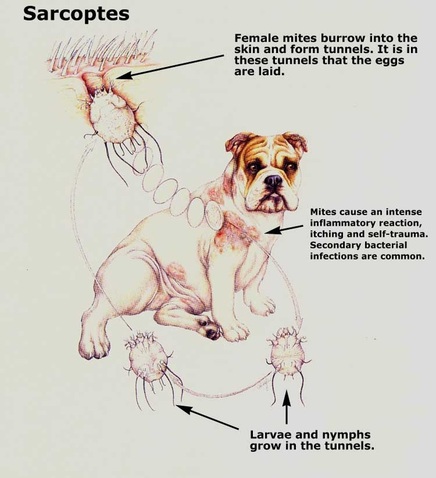
Sarcoptic mange, it is caused by a microscopic, oval-shaped and light-colored mite called Sarcoptes scabei (in dogs) and notoedric mange is caused by an almost round in dorsal view Notoedres cati (in cats). Their life cycles are very similar.
In all hosts, the mites tunnel in the epidermis and produce an intense itch and the condition is often referred to as canine or feline scabies. A substance from the mites' bodies causes an allergic reaction in the host's skin that results in intense itching and discomfort.
Adult mites feed on the serum, clear component that oozes into the tunnels from the surrounding irritated tissue. The mite's larvae and nymphs stages also feed on serum and skin debris.
Adult Sarcoptes scabiei are approximately 300-500 μm long. Sarcoptic mites breed very quickly and will eventually cover the entire animal if not treated.
Different varieties of Sarcoptes scabiei infest a wide range of mammalian hosts, including dogs and other canids, horses, cattle and humans. Cats are rarely infested with this mite.
Notoedres cati occurs in cats and other members of the Felidae family throughout the world, including ocelots, Florida panthers, tigers, bobcats, lynx, snow leopards, and cheetahs. Adults are approximately 200 to 240 μm diameter. Associated clinical signs include intense itching and hair loss that may be accompanied by self mutilation, weight loss, fever, or debilitation and sometimes death.
Sarcoptic and notoedric mange are highly contagious as the mites transfer easily between hosts. Humans exposed to infested animals are commonly affected.
The sarcoptic mange primary lesions are the itchy red bumps. Later, these become associated with thick yellow-grey, scale/crusts, especially on the ears. The lesions are characteristically present at the edge of the ears, elbows, hocks, chest and abdomen and can become widespread. Scratch marks covered with blood and crusts are seen. Inflammation of the lymph nodes is common.
The Notoedric mange lesions include thickening of the skin with a leathery appearance and gray crusts and scale on the ear tips, face, and distal extremities. Not always will all these areas be affected.
In all hosts, the mites tunnel in the epidermis and produce an intense itch and the condition is often referred to as canine or feline scabies. A substance from the mites' bodies causes an allergic reaction in the host's skin that results in intense itching and discomfort.
Adult mites feed on the serum, clear component that oozes into the tunnels from the surrounding irritated tissue. The mite's larvae and nymphs stages also feed on serum and skin debris.
Adult Sarcoptes scabiei are approximately 300-500 μm long. Sarcoptic mites breed very quickly and will eventually cover the entire animal if not treated.
Different varieties of Sarcoptes scabiei infest a wide range of mammalian hosts, including dogs and other canids, horses, cattle and humans. Cats are rarely infested with this mite.
Notoedres cati occurs in cats and other members of the Felidae family throughout the world, including ocelots, Florida panthers, tigers, bobcats, lynx, snow leopards, and cheetahs. Adults are approximately 200 to 240 μm diameter. Associated clinical signs include intense itching and hair loss that may be accompanied by self mutilation, weight loss, fever, or debilitation and sometimes death.
Sarcoptic and notoedric mange are highly contagious as the mites transfer easily between hosts. Humans exposed to infested animals are commonly affected.
The sarcoptic mange primary lesions are the itchy red bumps. Later, these become associated with thick yellow-grey, scale/crusts, especially on the ears. The lesions are characteristically present at the edge of the ears, elbows, hocks, chest and abdomen and can become widespread. Scratch marks covered with blood and crusts are seen. Inflammation of the lymph nodes is common.
The Notoedric mange lesions include thickening of the skin with a leathery appearance and gray crusts and scale on the ear tips, face, and distal extremities. Not always will all these areas be affected.
Cheyletiella Mange
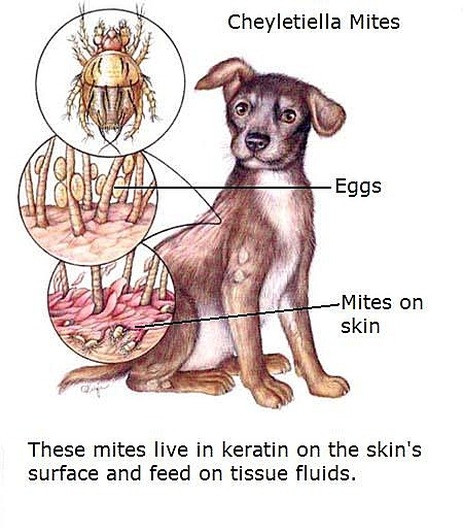
Cheyletiella mange or cheyeletiellosis, often referred to as "walking dandruff", is caused by mites visible to the naked eye. The adult mites are about 0.385 millimeters long.
Usually, Cheyletiella yasguri affects dogs and Cheyletiella
blakei affects cats. However, these mites are not absolute host specific.
Cheyletiella spp. are very mobile and are contagious by direct contact. These mites have been found on fleas, lice, and flies; it has been hypothesized that this is one means by which they move between hosts.
These mites are not associated with hair follicles (like demodex mites) and do not burrow (like sarcoptic and notoedric mites). Instead, they move rapidly on the surface of the skin in pseudo-tunnels of epidermal debris.
The cheyletiella mite feeds on the keratin layers of the skin and the sebaceous secretions.
Of all of the most common types of dog and cat mange,
cheyletiella mange is the least serious and has the mildest effects. Though this mange is relatively harmless, it is highly contagious to other mammals, including humans.
The most common signs of a cheyletiella infestation are the dusting or dandruff and mild to moderate itching. The itching is not as intense as scabies (sarcoptic and notoedric manges in dogs and cats, respectively).
A cheyletiella mite infestation causes scaling along the backbone and ribcage of the animal where the mites like to take up residence. The lesions develop a central area of necrosis that is considered highly diagnostic.
Usually, Cheyletiella yasguri affects dogs and Cheyletiella
blakei affects cats. However, these mites are not absolute host specific.
Cheyletiella spp. are very mobile and are contagious by direct contact. These mites have been found on fleas, lice, and flies; it has been hypothesized that this is one means by which they move between hosts.
These mites are not associated with hair follicles (like demodex mites) and do not burrow (like sarcoptic and notoedric mites). Instead, they move rapidly on the surface of the skin in pseudo-tunnels of epidermal debris.
The cheyletiella mite feeds on the keratin layers of the skin and the sebaceous secretions.
Of all of the most common types of dog and cat mange,
cheyletiella mange is the least serious and has the mildest effects. Though this mange is relatively harmless, it is highly contagious to other mammals, including humans.
The most common signs of a cheyletiella infestation are the dusting or dandruff and mild to moderate itching. The itching is not as intense as scabies (sarcoptic and notoedric manges in dogs and cats, respectively).
A cheyletiella mite infestation causes scaling along the backbone and ribcage of the animal where the mites like to take up residence. The lesions develop a central area of necrosis that is considered highly diagnostic.
Otodectic Mange
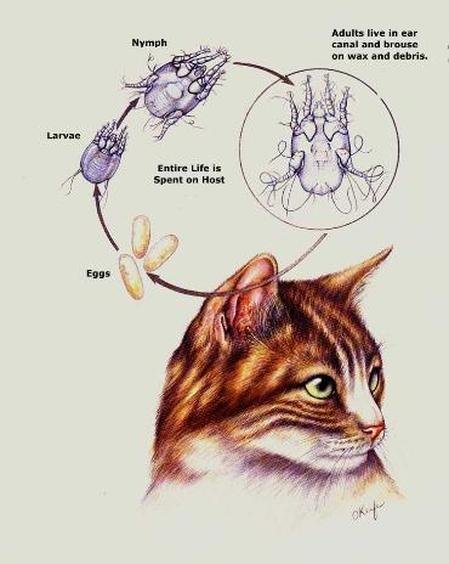
Otodectic mange, or ear mites, are external parasites that live on the surface of the skin, rather than tunneling into it. These ear mites are highly contagious to cats, dogs and other mammals (rabbits, ferrets etc.) but not to humans.
Otodectes cynotis mites are the most common cause of inflammation of the outer ear canal in mammals. It has been estimated that over 50% of otitis externa cases in dogs and 85% of cases in cats involve infestations with Otodectes.
These mites feed upon epidermal debris, tissue fluids and ear wax causing itch, severe inflammation and discomfort.
Young animals are most susceptible to infestation and, as the mites are highly contagious and not host-specific, all in-contact animals should be presumed to be infected. Pets most typically contract ear mites from other pets who are already infected with the parasites. Simply socializing or playing with other animals is often enough to spread this condition.
Although the name would suggest otherwise, ear mites can live on any part of the body. If ear mites migrate to other parts of the body they cause rashes and skin irritations. The mites are highly likely to travel to the tail area in animals that wrap around the body when sleeping or resting.
The typical behavior exhibited by infected animals is frequent head shaking and scratching at the ears because the ear mites cause severe itching. Dogs may also scratch at their ears and try to rub them with their paws, on the ground, or against an object.
Another warning sign of an ear mite infection includes a dark discharge from the afflicted ear(s) similar to coffee grounds in appearance. This discharge consists of earwax, blood, biochemicals and the actual ear mites. Continuous scratching can lead to secondary infections which then cause an unpleasant smell that accompanies the dark excretions from the ears. The ear flaps can become red, excoriated, crusted and scabbed.
If the infection is left untreated, the parasites can break the eardrum, migrate inside the inner ear and cause a very severe middle ear disorder. This invasion could ultimately cause the animal to loose balance, experience disorientation, and possibly become deaf.
When mites are present in one dog or cat in a household, it is essential that all dogs and cats in the household be treated at the same time.
Otodectes cynotis mites are the most common cause of inflammation of the outer ear canal in mammals. It has been estimated that over 50% of otitis externa cases in dogs and 85% of cases in cats involve infestations with Otodectes.
These mites feed upon epidermal debris, tissue fluids and ear wax causing itch, severe inflammation and discomfort.
Young animals are most susceptible to infestation and, as the mites are highly contagious and not host-specific, all in-contact animals should be presumed to be infected. Pets most typically contract ear mites from other pets who are already infected with the parasites. Simply socializing or playing with other animals is often enough to spread this condition.
Although the name would suggest otherwise, ear mites can live on any part of the body. If ear mites migrate to other parts of the body they cause rashes and skin irritations. The mites are highly likely to travel to the tail area in animals that wrap around the body when sleeping or resting.
The typical behavior exhibited by infected animals is frequent head shaking and scratching at the ears because the ear mites cause severe itching. Dogs may also scratch at their ears and try to rub them with their paws, on the ground, or against an object.
Another warning sign of an ear mite infection includes a dark discharge from the afflicted ear(s) similar to coffee grounds in appearance. This discharge consists of earwax, blood, biochemicals and the actual ear mites. Continuous scratching can lead to secondary infections which then cause an unpleasant smell that accompanies the dark excretions from the ears. The ear flaps can become red, excoriated, crusted and scabbed.
If the infection is left untreated, the parasites can break the eardrum, migrate inside the inner ear and cause a very severe middle ear disorder. This invasion could ultimately cause the animal to loose balance, experience disorientation, and possibly become deaf.
When mites are present in one dog or cat in a household, it is essential that all dogs and cats in the household be treated at the same time.
Important Note - Please Read
There are many skin conditions that can have a similar appearance. These include allergic reactions (to flea bites, commercial food, grooming products or environmental irritants), fungal or bacterial infections, mites, an immune system malfunction or other causes.
It is always advisable to seek an accurate diagnosis from a competent veterinary doctor who will evaluate the symptoms and perform the appropriate tests (i.e. such a deep skin scraping) to determine if your pet's problem is the result of a mite infestation.
If your pet's veterinary diagnosis is positive for mange and you choose to use a treatment prescribed by your vet, make sure that it does not contain harmful substances such as pesticides or other dangerous chemicals. We recommend to always check the http://www.drugs.com/vet/ website for information on the side effects of any prescribed medication.
We have found that prescribed demodectic mange medications that contain toxic chemicals contribute to the weakening of the immune system. These medications may temporarily eliminate the mites and the skin condition but the problem often returns making it a vicious cycle.
It is important to note that there are serious risks associated with the most commonly prescribed medications Ivermectin and Amitraz (product brands include Mitaban, Ridd, Aazdieno, Acarac, Aludex, Amitraze, Avartin, Baam, Edrizan, Maitac, Mitac, Triatox, Triatix, Vapcozin Taktic, Triazid, Topline, Tudy, Ectodex, Garial, Danicut, Ovidrex, Acadrex, Bumetran, and Ovasyn). Both medications can have serious side effects to dogs (due to sensitivity or breed type). See links below for further information.
http://www.ncbi.nlm.nih.gov/pubmed/18627233
http://www.drugs.com/sfx/ivermectin-side-effects.html
http://www.petmd.com/dog/conditions/toxicity/c_dg_ivermectin_toxicity
http://www.livestrong.com/article/32684-ivermectin-toxicity-signs/
http://www.drugs.com/vet/mitaban.html
http://www.petpoisonhelpline.com/poison/amitraz/
http://www.peteducation.com/article.cfm?c=2+1677&aid=2230
http://www.ncbi.nlm.nih.gov/pmc/articles/PMC1719437/
http://www.petmanage.com/dog-health/what-is-amitraz-toxicity.html
It is always advisable to seek an accurate diagnosis from a competent veterinary doctor who will evaluate the symptoms and perform the appropriate tests (i.e. such a deep skin scraping) to determine if your pet's problem is the result of a mite infestation.
If your pet's veterinary diagnosis is positive for mange and you choose to use a treatment prescribed by your vet, make sure that it does not contain harmful substances such as pesticides or other dangerous chemicals. We recommend to always check the http://www.drugs.com/vet/ website for information on the side effects of any prescribed medication.
We have found that prescribed demodectic mange medications that contain toxic chemicals contribute to the weakening of the immune system. These medications may temporarily eliminate the mites and the skin condition but the problem often returns making it a vicious cycle.
It is important to note that there are serious risks associated with the most commonly prescribed medications Ivermectin and Amitraz (product brands include Mitaban, Ridd, Aazdieno, Acarac, Aludex, Amitraze, Avartin, Baam, Edrizan, Maitac, Mitac, Triatox, Triatix, Vapcozin Taktic, Triazid, Topline, Tudy, Ectodex, Garial, Danicut, Ovidrex, Acadrex, Bumetran, and Ovasyn). Both medications can have serious side effects to dogs (due to sensitivity or breed type). See links below for further information.
http://www.ncbi.nlm.nih.gov/pubmed/18627233
http://www.drugs.com/sfx/ivermectin-side-effects.html
http://www.petmd.com/dog/conditions/toxicity/c_dg_ivermectin_toxicity
http://www.livestrong.com/article/32684-ivermectin-toxicity-signs/
http://www.drugs.com/vet/mitaban.html
http://www.petpoisonhelpline.com/poison/amitraz/
http://www.peteducation.com/article.cfm?c=2+1677&aid=2230
http://www.ncbi.nlm.nih.gov/pmc/articles/PMC1719437/
http://www.petmanage.com/dog-health/what-is-amitraz-toxicity.html
